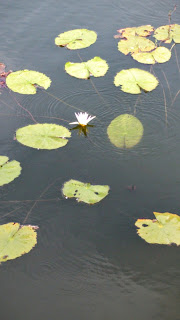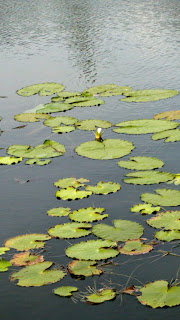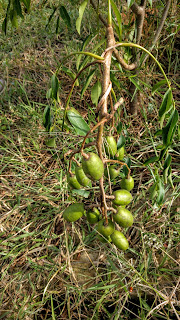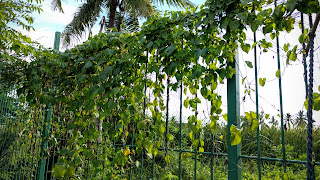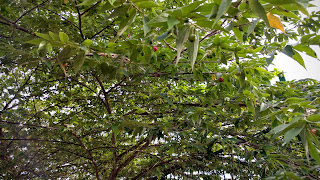Walking around the land today, I noticed a number of lily pads in the pond that seem to be flourishing:
But it was the new food plants that Praew pointed out to me that really got my attention.
Praew pointed out a little “makok” tree (ambarella?). I hadn’t noticed it before although she planted it last year. The fruit are edible and is supposed to have a pineapple-mango flavor according to Wikipedia. It has a nice little bunch of fruit growing now…
I’m curious to taste it.
In addition, we are now getting out first harvest of “dogkachon” flower that tastes really good stir fried into an omelette.
The “dogkachon” are the bunches of slightly yellowish flower on the left side of the picture above. But on the right toward the top, you can see some conical flowers called “dogchomjan”. These are also edible and are usually cooked in a vegetable stirfry, although I have never eaten them before.
Nearby was a little shrub that sprouted up on its own called “pakom Thai” (“Thai spinach”, a kind of amaranth). The name confuses me because I thought amaranth was native to South America, but hey, I guess Thai people can call it whatever they want. The leaves are supposed to be eaten similar to spinach. (Raw, steamed, or in a stir fry.)
(I’ve had amaranth breakfast cereals before… I wonder if the seeds of this plant can be used the same way as “normal” amaranth grains.)
But my biggest and most pleasant surprise was this tree which has little red berries ripening on it now:
It is called “tdoan takob” (Indian plum). This tree also wasn’t planted but simply grew on its own. The workers mentioned that it is edible but none of them like it because of a funny taste for this fruit. I’m not sure they tried this particular tree. Praew and I saw a few bright red berries today and I decided to taste one to see for myself. It was delicious! I would describe it as having the texture exactly like a blueberry, but the flavor of a “noina” (custard apple or cherimoya). It has a hint of an astringent aftertaste, but only a hint. I also read online that in Indonesia, they roll the fruit in their hands to bruise it which reduces or eliminates the astringent taste. I barely even noticed it though.
So we picked a small bunch of the ripe ones and I’ll try it out…
This could certainly be added as one of the variety of fruit I use in my “yogurt topped with assorted fruit” breakfasts.
Very cool new find!
And given that it is growing on our land without being planted nor watered nor otherwise tended, it certainly isn’t a difficult crop to grow on our land. I have a big fondness for these “indigenous plants”, particularly the ones that are as tasty as this one. 🙂

